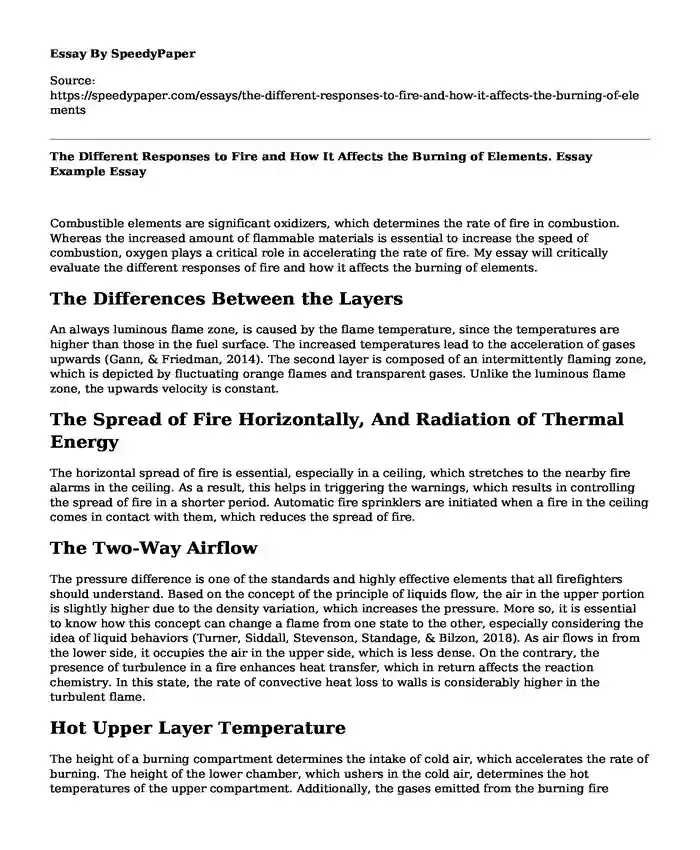Combustible elements are significant oxidizers, which determines the rate of fire in combustion. Whereas the increased amount of flammable materials is essential to increase the speed of combustion, oxygen plays a critical role in accelerating the rate of fire. My essay will critically evaluate the different responses of fire and how it affects the burning of elements.
The Differences Between the Layers
An always luminous flame zone, is caused by the flame temperature, since the temperatures are higher than those in the fuel surface. The increased temperatures lead to the acceleration of gases upwards (Gann, & Friedman, 2014). The second layer is composed of an intermittently flaming zone, which is depicted by fluctuating orange flames and transparent gases. Unlike the luminous flame zone, the upwards velocity is constant.
The Spread of Fire Horizontally, And Radiation of Thermal Energy
The horizontal spread of fire is essential, especially in a ceiling, which stretches to the nearby fire alarms in the ceiling. As a result, this helps in triggering the warnings, which results in controlling the spread of fire in a shorter period. Automatic fire sprinklers are initiated when a fire in the ceiling comes in contact with them, which reduces the spread of fire.
The Two-Way Airflow
The pressure difference is one of the standards and highly effective elements that all firefighters should understand. Based on the concept of the principle of liquids flow, the air in the upper portion is slightly higher due to the density variation, which increases the pressure. More so, it is essential to know how this concept can change a flame from one state to the other, especially considering the idea of liquid behaviors (Turner, Siddall, Stevenson, Standage, & Bilzon, 2018). As air flows in from the lower side, it occupies the air in the upper side, which is less dense. On the contrary, the presence of turbulence in a fire enhances heat transfer, which in return affects the reaction chemistry. In this state, the rate of convective heat loss to walls is considerably higher in the turbulent flame.
Hot Upper Layer Temperature
The height of a burning compartment determines the intake of cold air, which accelerates the rate of burning. The height of the lower chamber, which ushers in the cold air, determines the hot temperatures of the upper compartment. Additionally, the gases emitted from the burning fire increase the output of the top layer, which in turn increases the temperatures as well.
Neutral Plane
A neutral plane is defined as the shift in a gradient of the cold air intake, as compared to the emission of the hot air from a burning element (Filkov, Duff, & Penman, 2018). The change in gradient increases the amount of fire, as cold air with a higher density is sucked in to increase the amount of fire, while the amount of hot air gradually rises on the other hand. The neutral plane is attained once, the airflow in a burning object is intercepted, as the gradient of these two elements is brought into a normal state.
The Essence of Understanding the Neutral Plane
The neutral plane defines the amount of fire in a burning building. In a search and rescue mission, it is essential to understand the root cause of a fire. Air contains 21% of oxygen, which is a critical element that fuels fire (Qiao, Shao, Wei, & Zhang, 2019). However, in a scenario where the inflow of cold air is not regulated, burning increases consuming the entire building. As a result, it is essential to understand this concept, as the interception of cold air will reduce the rate of fire, hence making it possible for a search and rescue mission.
Conclusion
Fire spread and behavior vary with the increase of essential elements such as combustible materials and oxygen. On the contrary, it is crucial in understanding the reduction of oxygen supply in a narrow path will increase the velocity of the flames due to pressure variation.
References
Filkov, A. I., Duff, T. J., & Penman, T. D. (2018, September). Extreme fire behaviors: Surveying fire management staff to determine behavior frequencies and importance. In Bushfire and Natural Hazards CRC & AFAC conference (pp. 5-8).
Gann, R., & Friedman, R. (2014). Principles of fire behavior and combustion. Jones & Bartlett Publishers. ISBN-10: 0-7637-5717-9
Qiao, R., Shao, Z., Wei, W., & Zhang, Y. (2019). Theoretical investigation into the thermo-mechanical behaviors of tunnel lining during RABT fire development. Arabian Journal for Science and Engineering, 44(5), 4807-4818. https://doi.org/10.1007/s13369-018-3555-x
Turner, P. J., Siddall, A. G., Stevenson, R. D., Standage, M., & Bilzon, J. L. (2018). Lifestyle behaviors and perceived well-being in different fire service roles. Occupational medicine, 68(8), 537-543. doi 10.1093/occurred/kqy110.
Cite this page
The Different Responses to Fire and How It Affects the Burning of Elements. Essay Example. (2023, Mar 21). Retrieved from https://speedypaper.net/essays/the-different-responses-to-fire-and-how-it-affects-the-burning-of-elements
Request Removal
If you are the original author of this essay and no longer wish to have it published on the SpeedyPaper website, please click below to request its removal:
- Personal Statement for Graduate School, Essay Example
- Free Essay on Academic and Career Goals: Computer Information Systems
- Free Essay on Computer Security Auditing
- Essay Sample on Children's Development Through Superhero and War Games
- Free Essay about the Use of the Drugs Narcan and Naloxone
- Free Essay Sample: Culture and Structure
- Creating an Ideal State. Essay Example
Popular categories





